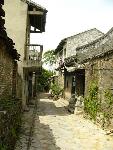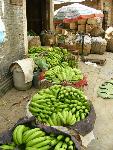- Getting around Lijiang. Dont stay in the Old Towns more than 2 days, there is nothing to do. KRISS Oct 9, 2013 05:46
- 2013 Beijing Temple Fair BENNYLAU Feb 26, 2013 03:29
- Malaysian traveling from KUL - LAX vis Shanghai PVG ZATI_DY Jan 3, 2013 20:15
Living in History
- Views: 5591
- |Vote: 3 1
- |Add to Favorites
- |Recommend to Friends
Finding the Way
Guangxi Province is dotted with thousands of small towns, just as are most of China's provinces, in which the millionfold members of China's agrarian population live out their daily remote existences. Whilst most of these little towns and villages are poor, many retain traces of ancestral developments or remnants of the dwellings of the wealthy dating back from long ago in China's history. Some (perhaps thousands) of these places have yet to come to light and remain hidden in obscurity. Others have been noted and marked out for tourist development, and some are in the curious position of being both a small, poor village and a fascinating tourist destination at the same time.
Yangmei is such a place - an hour away from Nanning city by bumpy bus, it is a very well-preserved town with many impressive stone edifices, some of which date back to the Ming Dynasty, and all of which are still in use. Hidden within a vast banana plantation in Guangxi's Jiangxi Prefecture, Yangmei's historical significance has seen it become a charming excursion from the provincial capital that gives visitors a unique insight into the Guangxi of today and of ages past. Since it began to be noticed around ten years ago, several movies have been shot there owing to its pristine condition with relatively few obvious modern appendages, and Yangmei continues to enjoy an increasing reputation as a window into Guangxi's past.
I was on my last day in my visit to Nanning city and very much wanted to see the place, but because Yangmei has yet to really make a big name for itself, I was finding it excruciatingly difficult to find transport. Staff at my hotel had pointed vaguely in a westerly direction away from the railway station, but after half an hour of wandering past scores of 'hairdresser' salons replete with young psirens calling at me with throat-curdling 'hellos', I had gotten no further, and no-one I asked seemed to know what I was talking about.
I dropped in on a restaurant, still not having eaten, and ordered a simple meal of vegetables and egg rice, which was then not delivered until after the staff had had their meeting - lining up in the middle of the restaurant being chided by their restaurant manager, and then forced to chant their restaurant slogans and clap their hands like kindergarten kids. I ate hungrily when it was finally served, and was shocked to discover at the end of it all that the most expensive dish had been the only one that I'd not actually seen the price of - plain old egg rice - which was half the price of the entire meal! Having been unceremoniously ripped off, I was in little good mood to keep up my energies, and so was considering changing plans and heading for the museum instead when I noticed a travel agency: the staff there pointed me in the right direction. Just a hundred metres west of the station and down a little side road to the south on Huaqiang Lu, I found a small bus park waiting in the middle of which were a couple of dull green busses marked 'Yangmei'.
En Route for Yangmei
I thankfully got aboard and did a double-take - far from looking like a tourist bus of any description, this was a run-down, non-conditioned and very smelly vehicle carrying passengers who were obviously from the countryside returning home. I did consider briefly that Yangmei's reputation may have been exaggerated, but in any case I was aboard, out of the direct heat for a little while and steadily moving deeper into the Guangxi countryside.
I've been through provinces that have impressed me with their rich, green blanket of vegetation before, but Guangxi's layer of green seemed to me to top them all. Guangxi borders on the south with Vietnam, and everything that is often depicted of the latter - the endless rice paddies, the grey oxen with tapering horns, the circular pointed bamboo hats, the lush bush and forest and rolling tree-covered mountains - all of this is true for Guangxi. The further we moved out from the city, the faster the realm of the countryside closed in. Workers in the fields bent over their crops as shoeless children with wild eyes peered out at the passing bus. Beasts of burden on the roads were flayed out of the way of the approaching vehicle by farmers with small whips of straw.
We came to a river where the road abruptly stopped, and we were all requested to get out of the bus. An old vehicular ferry lay shunted up on the riverbank, and the bus bumped its way over the iron ramp up onto the ferry platform. A few light trucks filled with produce did the same, and we passengers followed them on board. The ferry was chained to a tugboat, and the helmsman pulled at his levers and twirled the wheel in the direction of the opposite shore. We glided, or rather chugged, across the surface of the water. A few heavily tanned locals were standing in their underpants soaping themselves in the silty river just a short way from the boat - they paused to watch us sail by. In several minutes we'd already reached the opposite road - our bus unceremoniously, and in rather too much hurry, veered off the ramp and we all got on, continuing our journey deep into Guangxi's Jiangxi prefecture.
We had reached the banana fields - great hanging clumps of green bananas hung at the roadside on each side of the bus, and we occasionally had to steer around carts filled with the fruit, being collected by local pickers. As we continued, the bus passengers began to alight at the most unexpectedly remote spots - each one collected their bamboo carrying sticks and heavy sacks from the stack at the front of the bus, and stepped out - hanging a sack at each end, they shouldered the cane and made their way out into the banana fields, on their way home.
Finally, we came to the Yangmei scenic area - a lone ticket office stood at the roadside, and the bus attendant, eager to receive her percentage from ticket sales, collected the entry fees from the four or five people remaining on the bus who'd come to see the ancient village. Tickets are RMB10 each, but she whispered to each of us that she could get us all in as students for half price - so we all handed over our five yuan, and within a few moments she returned with our tickets. Corruption, it seems, exists at every level in this society...
Yangmei Guzhen
Beyond the ticket office the roads seemed to clear up considerably, the plantation itself seemed to become neater and more orderly, and before long we had arrived in the public square. No touts horded at the door of the bus offering produce or guide services, although after I had stepped off, one elderly fellow came up to me and asked if I wanted to ride around the city in his ricksha - I politely declined, and he happily sauntered off to his home, where I could see his wife was waiting for him with a cup of tea.
Yangmei is a very small village, made up of the kinds of old, traditional grey-brick houses you may have seen in Chinese historical movies. Although I did get the impression that the general condition of the average home had been improved somewhat since the village had achieved tourist fame - lending a slightly put-on air to the place - there was no denying that Yangmei is a thoroughly charming place to see, and a valuable insight into how towns such as this would have looked a few hundred years before.
Many of the houses around the town are around 400 years old, placing them for construction dates in the Ming Dynasty. Distinguishable by their clean, brownish bricks and green tiles, these simply constructed and somewhat elegant homes are known to the locals as 'seven stake' houses, owing to their having seven stakes standing on end from the front to the back rooms of the houses.
Others are of Qing origin, making them a mere 200 years old. By the riverside a whole street, called Lin Jiang Jie, exists more or less in its original condition, greenish unevenly-placed flagstones pounded into the earth, flanked by Qing Dynasty house fronts. A little farther back into the town is an entire manor constructed by a Qing Dynasty businessman that has been preserved in exemplary condition. Although it is still inhabited, locals tolerate tourists to wander freely inside and enjoy the design and simple artistic flourishes within.
Yangmei's most picturesque area has to be on the riverside, near an old gate marked Jinma Jie - a public square of sorts faces the open river, dotted with houseboat farms collecting fish. This is the place to rest after wandering around in the hot sun and soaking in the age-old atmosphere - a spot that is so peaceful you could spend all day sitting and watching the boats go by in the shade of the trees. That's just what the locals seemed to be doing - despite the fact that their home has become a period piece and something of a museum, they seem to shoulder the attention well and largely ignored the few tourists, preferring instead to carry on their own traditional existence deep in rural Guangxi.






 Copyright © 1998-2025 All rights reserved.
Copyright © 1998-2025 All rights reserved.
1.
May 1, 2013 01:18 Reply
Mr.ROY LOW from Singapore said:
Very frank and nice article written by Mr. Mishen, will like to travel to Nanning soon. I heard about some famous wood craft items in Nanning. Can anyone gives me the address or email address, so I can check it out. Thanks
2.
Sep 24, 2006 22:50 Reply
CHYNAGYRL said:
it must be nice to wander around in Guangxi! Yangshuo, was by far, the most beautiful place I've seen in China. I felt like I left a piece of my heart there... There's a tv commercial that says that will happen to visitors to Guilin, and it really does happen!